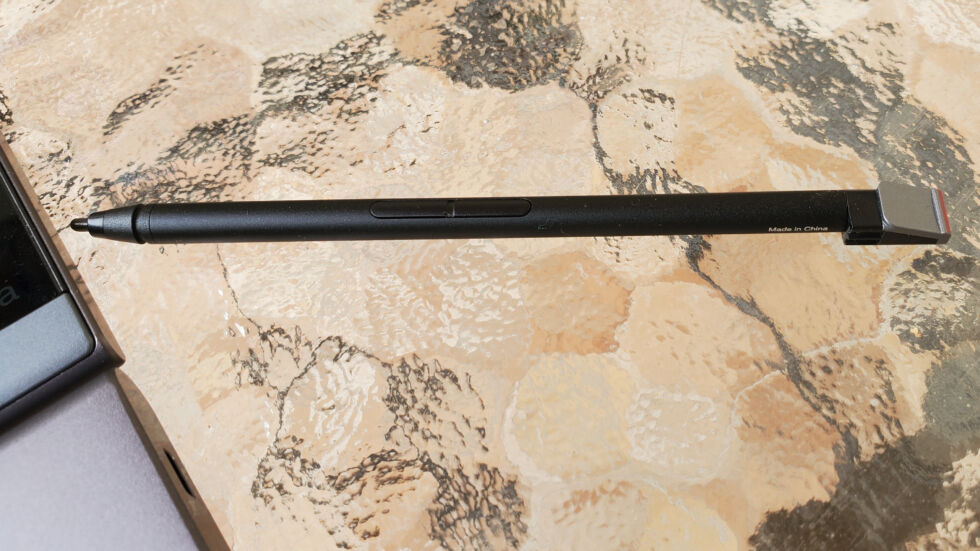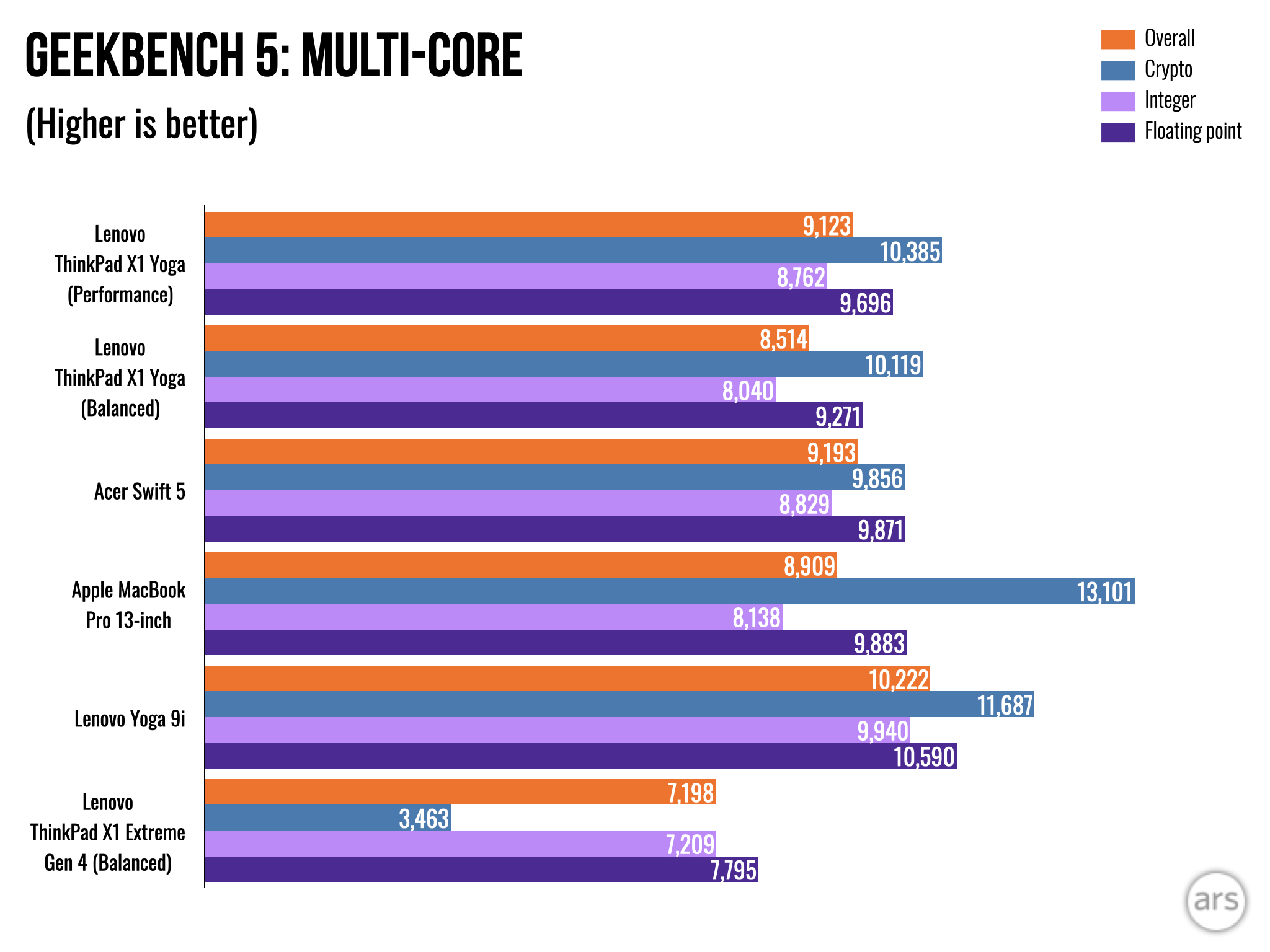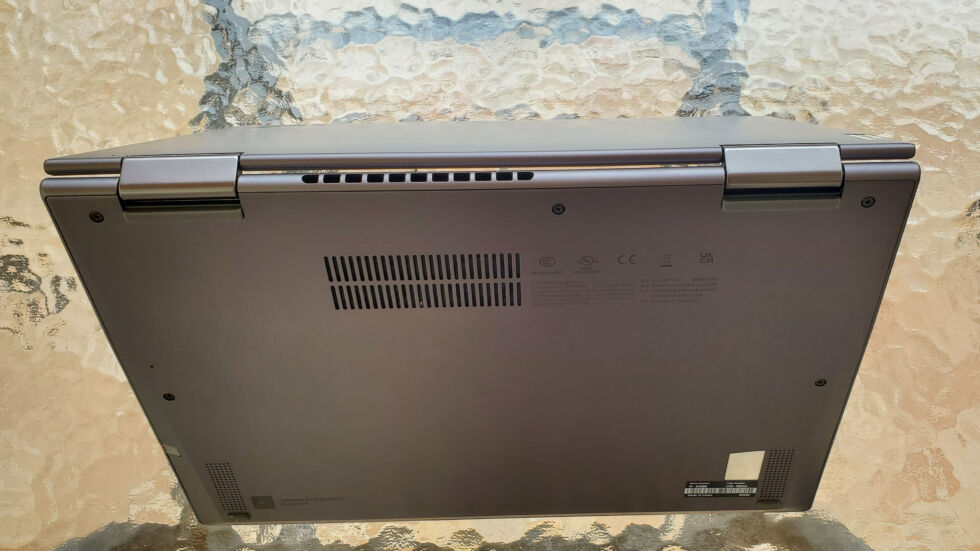
| Specs at a glance: Lenovo ThinkPad X1 Yoga Gen 7 | |||
|---|---|---|---|
| Worst | Best | As reviewed | |
| Screen | 14-inch 1920×1200 IPS touchscreen @ 60 Hz | 14-inch 3840×2400 IPS OLED touchscreen @ 60 HZ | 14-inch 1920×1200 IPS touchscreen @ 60 Hz |
| OS | Windows 11 Home | Windows 11 Pro | Windows 11 Pro |
| CPU | Intel Core i5-1240P | Intel Core i7-1280P | Intel Core i7-1260P |
| RAM | 8GB LPDDR5-5200 | 32GB LPDDR5-5200 | 16GB LPDDR5-5200 |
| Storage | 256GB SSD | 1TB SSD | 512GB SSD |
| GPU | Intel Iris Xe | ||
| Networking | Wi-Fi 6E, Bluetooth 5.2 | ||
| Ports | 2x USB-C (Thunderbolt 4), 2x USB-A (3.2 Gen 1), 1x HDMI 2.0b, 1x 3.5 mm jack | ||
| Size | 12.38×8.75×0.61 inches (314.4×222.3×15.53 mm) |
||
| Weight | Starts at 3 lbs (1.38 kg) | ||
| Battery | 57 WHr | ||
| Warranty | 1 year | ||
| Price (MSRP) | $1,589.40 | $2,279.50 | $1870.03 |
| Other | Stylus, optional 4G LTE | Stylus, optional 4G LTE | Stylus |
The Lenovo ThinkPad X1 Yoga, now in its seventh iteration ($1,870.03 MSRP as tested, as of writing), continues its modern take on the business-focused ThinkPad. It has the durability expected of a business machine, as well as smooth navigation underscored by a thoughtfully programmed keyboard fit for frequent typists, and, of course, that famous red nub.
However, the laptop doesn't necessarily outperform high-end consumer laptops, even some with slightly cheaper price tags. And similar to other ThinkPads we've tested, heat in its Best performance mode is so much of an issue that even light workloads will run the machine so warm that you won't want to touch it in certain areas.
Table of Contents
ThinkPad styling

Naming tells you this machine is part Lenovo ThinkPad, part Lenovo Yoga, but the styling and tough build lean more toward the former. Yes, there's the same 360-degree hinge found on Lenovo Yoga 2-in-1s, as well as a modern, thin-and-light build in a dark gray that's more fun than the more traditional ThinkPad black. But the density and tough feel of the aluminum chassis combined with the deep keyboard, advanced trackpad, and famous red rubber nub all scream ThinkPad.
The ThinkPad X1 Yoga's chassis meets the US Military's MIL-STD 810H standard, which puts it through 20 test procedures around areas including exposure to extreme temperatures, mechanical shock, vibration, humidity, solar radiation, and sand and dust. It carries the carvings of ThinkPad logos on the lid and deck. The lid's logo has a watchful red light over the "i," letting anyone facing you know that the system is running. The deck's logo, meanwhile, sometimes scratched against my palm as I typed.

The ThinkPad X1 Yoga is 0.61 inches thick and starts at 3 lbs, making it thinner and lighter than some ThinkPads without Yoga heritage, like the ThinkPad X1 Extreme, which is available with a discrete GPU, is 0.72 inches thick with a touchscreen and weighs about 4.1 lbs.
But if thin and trim is what you're after, there are other options with similar specs, like the latest Acer Swift 5 (0.59 inches thick, 2.65 lbs).
 Left side.Scharon Harding
Left side.Scharon Harding Right side.Scharon Harding
Right side.Scharon Harding
And similar to those laptops, the ThinkPad X1 Yoga meets my minimum port requirements for avoiding immediate aggravation. The left side has two Thunderbolt 4 USB-C ports, a USB-A port, and HDMI 2.0b. The right side has a 3.5 mm jack and another USB-A jack. If I had the 4G LTE version of this laptop, I'd also have a slot for a Nano SIM card.
Keyboard, touchpad, and stylus
The ThinkPad X1 Yoga doesn't necessarily blow cheaper thin-and-lights with similar specs out of the water when it comes to productivity performance, but it's on a superior level when it comes to input, and that went a long way for daily use, like writing articles, surfing the web, or quickly marking an image.

The chiclet keyboard on the 2-in-1 is exemplary and easily accommodated the extreme amount of typing I do. Comfy dishes would hug my fingertips, and the keys required a noticeable amount of travel, 1.5 mm, to actuate, ensuring the scissor switches never felt mushy or flat but, rather, tactile.
The keyboard also claims to be spill-resistant; I wasn't bold enough to try this out.
I did try the preprogrammed function row (you can set the keys to their standard F1–F12 functions in Lenovo's app), especially F4, which reassuringly lit up when pressed to mute my mic, and F12, which I set to launch Ars Technica but can also be set to open an app or files or input text or a specific key sequence.
There are some less positive keyboard quirks, though. The ThinkPad design that swaps the Fn and Ctrl keys from their expected locations was annoying for this Windows user. You can swap the keys' input in the Lenovo Commercial Vantage app, but the legends, obviously, won't change. At least the default Ctrl key, which I use more often than Fn, is larger than the Fn.
You also have to make do with smaller arrow keys, but this didn't bother me because the arrow keys stick out in a way that's different from how the Page Up and Down do. That made it easy for me to differentiate the sets of keys without looking down.
The latest ThinkPad X1 Yoga's touchpad is 4.33 inches (110 mm) wide, just like that of its predecessor. It's a glass touchpad that's noticeably smoother than the touchpad on cheaper laptops, like the Swift 5. Its left- and right-click buttons have travel that's so deep that I never had to worry about accidental presses while swiping about. ThinkPads also stand out for the three buttons above the trackpad and red rubber TrackPoint, which you either love or hate to use.

The ThinkPad comes with a pen (you can also buy a replacement pen for $42) that I actually didn't lose because there's storage for it on the right side of the deck, where it charges. It's a simple thing so thin that it was hard to grip naturally at first. But the stylus proved quite responsive, even when hovering it above the laptop's touchscreen.
Performance
The configuration I tested has an Intel Core i7-1260P vPro processor with four performance cores (2.1-4.7 GHz), four efficient cores (1.5-3.4 GHz), 16 threads, and 18MB cache. Intel's P-series processors debuted with Intel's 12th Gen mobile chips and are similar to H-series but are expected to hit max speeds for shorter durations.
My configuration also has a 512GB PCIe 4.0 SSD, but if I had my druthers, I'd cough up the extra $20 (as of writing) to almost double the storage (SKU: 21CD000LUS). The RAM, regardless of which configuration you get, isn't replaceable, as it's soldered.
Benchmarks
For comparison, I've brought in a couple other machines that use the i7-1260p, plus a similarly priced MacBook and a pricier ThinkPad with a last-gen CPU and dedicated graphics card.
| Model | CPU | Graphics | RAM | SSD | Other | Price (as of press time) |
|---|---|---|---|---|---|---|
| Lenovo ThinkPad X1 Yoga Gen 7 | i7-1260P | Intel Iris Xe | 16GB LPDDR5-5200 | 512 GB | 1920×1200 IPS touchscreen | $1,870 |
| Acer Swift 5 | i7-1260P | Intel Iris Xe | 16GB LPDDR5-4800 | 1TB | 2560×1600 IPS touchscreen | $1,500 |
| Apple MacBook Pro 13-inch | M2 | M2 | 16GB (type and speed unspecified) | 1TB | 2560×1600 IPS display | $1,899 |
| Lenovo Yoga 9i | i7-1260P | Intel Iris Xe | 16GB LPDDR5-5200 | 512GB | 2800×1800 90 Hz OLED touchscreen | $1,730 (MSRP) |
| Lenovo ThinkPad X1 Extreme Gen 4 | i7-11800H | Nvidia GeForce RTX 3070, Intel UHD | 16GB DDR4-3200 | 512GB | 3840×2400 IPS touchscreen | $2,327.40 |
Our review focus has three performance modes: Best performance, Balanced, and Best power efficiency. The charts below reflect numbers for the laptops tested in Best performance and Balanced modes. Lenovo's laptop also has a feature called Intelligent Cooling, which, according to Lenovo's Vantage app, "adjusts fan speed, maximum performance, and manages your battery life." This was left off for testing.
The ThinkPad X1 Extreme, meanwhile, was tested in Balanced mode, as it got pretty toasty when using Best performance mode.
 Ars Technica
Ars Technica Ars Technica
Ars Technica Ars Technica
Ars Technica Ars Technica
Ars Technica
With the same CPU and speedier RAM, the ThinkPad X1 Yoga outperformed the Swift 5 in single-core performance in both tested performance modes. It also outperformed the ThinkPad X1 Extreme with a last-gen CPU. The Yoga 9i showed negligibly better numbers, and the M2-powered MacBook Pro scored 10.1 percent better than the ThinkPad X1 Yoga's best score in the overall single-core test.
In multi-core performance, the ThinkPad X1 Yoga and Swift 5 were in the same ballpark, with the Yoga 9i slightly outperforming. But the Swift 5 has a notably faster SSD than the ThinkPad X1 Yoga. (Note we don't have CPDT numbers available for the MacBook Pro or other ThinkPad, as this is a newer addition to our benchmark suite.)
 Ars Technica
Ars Technica Ars Technica
Ars Technica
The ThinkPad X1 Yoga showed decent graphics performance, despite trailing behind the Yoga 9i a bit. Of course, the ThinkPad Extreme with its discrete RTX 3070 graphics card blew away the other machines here. Apple's new M2 also showed off its graphical superiority.
Cooling
Lenovo says Gen 7 of the ThinkPad X1 Yoga has redesigned cooling under the keyboard for improved air intake. There's also a pair of fans, plus rear venting. But it still got pretty heated in Best performance mode.
Even with light workloads, the top-left region of the keyboard was almost always warm. It didn't take much for the laptop's spine to get too hot to touch, especially if using the laptop in Best performance mode for at least an hour. At that point, the spine and underside became too hot to touch comfortably, even if I was doing something as simple as running 12 browser tabs only.

The laptop's heat was much more manageable in Balanced mode, although the keyboard would still get a bit warm on the right side during light workloads, but for ultimate performance you'll have to deal with a distracting amount of heat.
In a nod to the laptop's business focus, the laptop carries Lenovo's ThinkShield portfolio of security hardware, software, and services. That includes a "self-healing" BIOS that purportedly won't brick in the case of a failed or interrupted BIOS update. According to press materials Lenovo shared, the laptop "keeps a back-up of the BIOS, so if there are any issues the system will revert to the older working BIOS." The ThinkPad also works with Tile tracking if you subscribe to Tile, download the app, and set it up.
Battery life

Lenovo told me the laptop can last for up to 14.9 hours on the MobileMark 2018 benchmark with the screen set to 250 nits, and 19.7 hours with local video playback and the screen set to 150 nits.
For comparison, the Swift 5 claims up to 9.5 hours on MobileMark or 14 hours of web browsing or video playback with the screen at 50 percent brightness. The Yoga 9i with its power-hungry OLED screen claims 10.5 hours on MobileMark 2018 and 14 hours of 1080p video playback when set to 150 nits. The MacBook Pro claims 17 hours of wireless web browsing, and ThinkPad X1 Extreme lasted for 8.4 hours on the PCMark Modern Office test when we tested it in Balanced mode and set to 200 nits.
Display
Like the Gen 6 ThinkPad X1 Yoga, Gen 7 has a 16:10, 14-inch screen. The taller aspect ratio is rather trendy among laptops this year, but in a business PC like the ThinkPad, where you're likely to be looking at long spreadsheets and emails, this feels sensible.
The laptop has an IPS panel, and the configuration I reviewed has 1920×1200 resolution and a 60 Hz refresh rate. There are no speedier options, like you'll find in, for example, the Yoga 9i, which is available with up to 90 Hz, but I'm fine with that in a business machine.

In addition to being notably dimmer than the cheaper Swift 5 clamshell, colors on the ThinkPad X1 Yoga's screen weren't as saturated or nuanced as, say, the Yoga 9i's OLED display. Greens, for example, didn't pop as much, and oranges that had shades of yellow and red on more premium screens just looked like a faded orange here.
Lenovo claims the display has 100 percent sRGB coverage, and I recorded 69.9 percent coverage of the wider DCI-P3 color space. For comparison, the Swift 5 hit 83.1 percent P3, the Yoga 9i's OLED display 123.2 percent, and the ThinkPad X1 Extreme 81.5 percent.
The laptop claims 1,000:1 contrast, which is common for an IPS display, although the Swift 5 (1,200:1) claims more, and we recorded more on the ThinkPad X1 Extreme (1,391:1). It also claims 100 percent sRGB coverage, and I recorded 71.1 percent coverage of the wider DCI-P3 color space. For comparison, we recorded 83.1 percent P3 coverage on the Swift 5, 123.2 percent on the Yoga 9i, and 81.5 percent on the ThinkPad X1 Extreme.

You can also get the machine with an OLED backlight, which can hit up to 500 nits but only 400 nits with HDR. It claims 100 percent coverage of the wider DCI-P3 color space, a sharper resolution of 3840×2400 (323.5 ppi), and Dolby Vision support. Expect this model to have a shorter battery life, though.
Webcam, mics, and speakers
Today's ThinkPad X1 Yoga has a sharper webcam than last year. This time, we're working with a 1080p, rather than 720p, camera with the option for infrared for Windows Hello facial recognition logins.
My favorite aspect is the physical camera cover that's so tiny and subtle that I didn't spot it at first. It proved easy to slide and showed firm movement. It's also easy to tell if the camera is on (a white light will be visible) or off (there's a red dot where the camera is).

The camera was pretty color-accurate and sharp enough for a laptop camera, so long as I had superior lighting conditions. In typical or subpar lighting conditions, like a lit room with moderate sunlight, the colors looked faded and the image lacked sharpness—even after playing with brightness, contrast, and Auto Exposure toggles in Lenovo's Vantage app.
For things like web calls, you'll also want to know about the four far-field microphones and the Dolby Voice app that lets you play with their AI capabilities:

And just like I could easily tell if the camera was on or not, I could quickly tell if I was muted by looking for the light on the F4 key.
The laptop has a speaker on the left and right sides of the keyboard, plus one speaker on the bottom-left corner of the deck and another on the bottom-right. Four speakers meant strong volume that didn't sound muffled. It doesn't have the warmth or bass of my best speakers, but it didn't make audio sound as tinny as the average ultralight laptop, including the Yoga 9i and Swift 5.
And for mild tweaking, the Dolby app offers Dolby Atmos sound profiles and an equalizer.

Lenovo ThinkPad X1 Yoga (Gen 7)
Elevated design, higher temps
You can eke out similar or even slightly better performance from laptops with mildly smaller price tags. But it's the ThinkPad X1 Yoga's elevated design that really sets it apart. Things like a more dense, hearty chassis feel, a deep-traveling, finger-hugging keyboard, robust speakers for an ultralight, and sturdy camera shutter go a long way in daily use.
Unfortunately, the laptop got uncomfortably hot in its Best performance mode during testing, even with light workloads.
Ultimately, the 2-in-1 will attract business users who want something sleek with a dignified, portable design but don't need to push their PC to the max constantly.
The good
- Exemplary keyboard
- Feels tough and looks good
- Subtle, effective camera shutter and volume/mic mute buttons
- Speakers aren't as tinny as you'd expect from a machine this thin
The bad
- Ctrl and Fn buttons are swapped (but reprogrammable)
- You may find slightly better performance from similar laptops in this price range
The ugly
- Parts of the laptop get too hot to touch comfortably when in Best performance mode
https://ift.tt/8Wc5Gfl
Technology
No comments:
Post a Comment